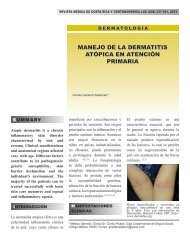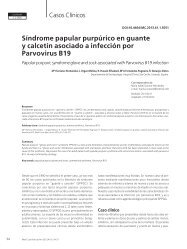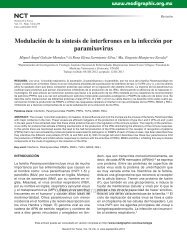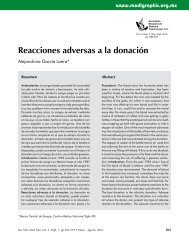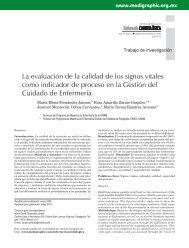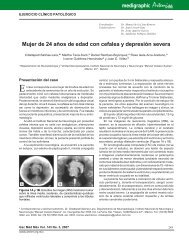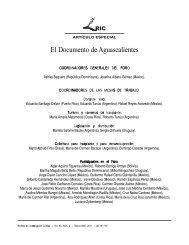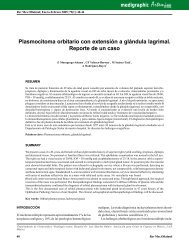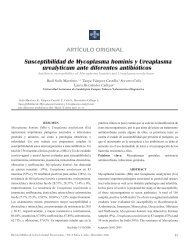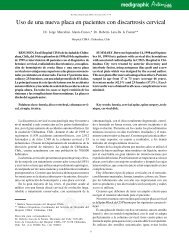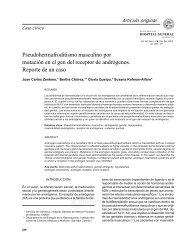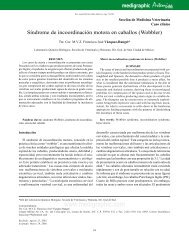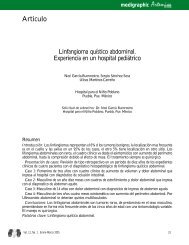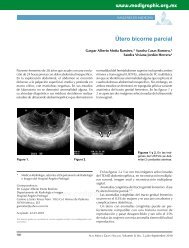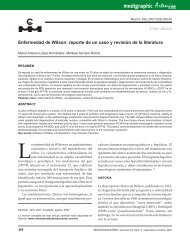Fanconi – Bickel Syndrome – two cases report - edigraphic.com
Fanconi – Bickel Syndrome – two cases report - edigraphic.com
Fanconi – Bickel Syndrome – two cases report - edigraphic.com
You also want an ePaper? Increase the reach of your titles
YUMPU automatically turns print PDFs into web optimized ePapers that Google loves.
164<br />
Case 1<br />
Case 2<br />
with continuous bicarbonate infusion calculated as per<br />
acid base deficit depending upon the gasometry. Due to<br />
persistent hyperglycemia, determination of C peptide<br />
level was requested, with result of 0.3 ng/mL, with reference<br />
value of 1.1- 5.0 ng/mL; Insulin level < 0.200μU/L<br />
with reference value of 5.0- 25μU/L. The antibiotic<br />
scheme was modified, started on Dicloxacillin, Cefotaxim<br />
and Fluconazole as Urine culture was positive for<br />
Candida Albicans of 100,000/HPF. With this, the child<br />
improved clinically, radiologically and values of laboratory<br />
examination, hence extubated and transferred to us<br />
for continued evaluation and treatment.<br />
The physical examination showed, Head circumfer-<br />
ence of 48 cm ( 50th centile for age), length of 73 c (<<br />
5th centile for age), weight of 11,100 g (< 25th centile<br />
for age); Doll-like face was more prominent, small thorax<br />
and rachitic changes noted in the costal cartilage. Distended<br />
abdomen with hepatomegaly of 6 x 5 x 5 cm<br />
(Figure 2), with genitals relevant to his age and sex also<br />
noted. Rest of the systemic examination was normal.<br />
Repeat Gasometry, C peptide, Insulin were requested<br />
and were continued to be below the normal values<br />
(metabolic acidosis, 0.3 ng/mL and 1.3μU/L respec-<br />
Annals of Hepatology 7(2) 2008: 163-167<br />
A B<br />
A B<br />
Figure 1. Liver tissue of Case 1 and Case 2: (A) PAS staining demonstrating glycogen accumulation and (B) Photograph of positive diastase<br />
test.<br />
www.m<strong>edigraphic</strong>.<strong>com</strong><br />
tively). Hence, the possibility of FBS associated with<br />
glycogenosis was considered. Due to persistent acidosis,<br />
Nephrology and Genetic opinion was sought.<br />
Serum and urinary electrolytes of 24 hours were repeated.<br />
While analyzing Phosphaturia, Negative anion<br />
gap curve of Hyperchloremic type was observed,<br />
this was <strong>com</strong>patible with tubulopathies (Figure 3<br />
and Table I).<br />
Radiography of long bones showed evidence of rickets.<br />
Ultrasonography of Abdomen showed hepatomegaly<br />
without diffuse hepatic parenchymal lesions. Kidneys,<br />
Pancreas and Spleen were normal in shape and size.<br />
In the beginning, the diagnosis of type I glycogenosis<br />
Von Gierke Disease was considered in this patient. How-<br />
ever, during the course of evolution, the patient presented<br />
with metabolic acidosis, due to renal tubular dysfunction,<br />
pre-prandial hypoglycemia with ketosis followed<br />
by postprandial elevated blood glucose , associated decreased<br />
Insulin and C Peptide levels, but at the same time<br />
not following the clinical course of type I diabetes too.<br />
After the biochemical analysis and renal functional test<br />
to demonstrate the proximal renal tubular dysfunction,<br />
with the results of glucosuria, phosphaturia, bicarbonate



